I like Lego. I got my first set back around age 5 (I still have
some of those well-chewed bricks), and have built off-and-on ever
since. Of course, I've tried to get both of my kids into building
as well. Together, they inherited two giant Rubbermaid storage
totes full of Lego. I give them chunks of it from time to time.
I've also bought sets for both of them. Ben is signed up for the
Lego Club Jr, so he gets a quarterly magazine with neat info and
photos of things other children have created.
IMHO, the instructional value of Lego is unmatched by most
toys.
Ben and I aren't quite ready to be building robots together, but
I've been teaching him about motion and gears, just a little. I had
a bunch of technic sets, plus the old Mindstorms NXT kit, so I have
a fair bit of motion components in the bins. Recently, I added some
of the newer Power Functions motors and battery sets, plus
a couple of their larger motors (order directly from Lego, for some
reason it's much cheaper when it comes to the motors)
There are three great Lego books I can't recommend highly enough
when it comes to teaching about motion (and learning some things
yourself). All three were written by Yoshihito Isogawa, who has
also authored several other books on Lego and Mindstorms.
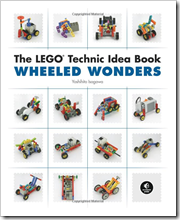
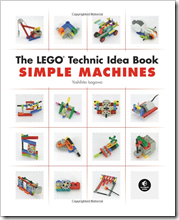
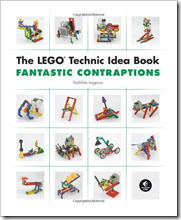
The components used span modern Lego history. You'll find the
old motors and the new. You'll see older gearboxes as well as new
ones. There will be something for pretty much everyone in these
books.
The three books are appropriate for anyone, even those who can't
yet read or don't speak/read English. All three use Lego/Ikea
wordless pictograms to tell you how the contraptions operate. You
won't find the nice Lego-style step-by-step construction
instructions (they'd be as thick as phone books if they did), but
you are able to infer them from the various diagrams. Most models
are explained in just one or two pages. Younger children will
definitely need help from the parents here which, of course, is
part of the fun.
Wheeled Wonders
The Wheeled Wonders book is all about making vehicles. Most have
motors, but some are simply pushed along and do things like spin a
prop on the top. The models range from the simple all the way to
fairly complex builds which have a main chassis which is
gear-driven by a removable second car which sits on top.
Here's an example of the page showing how to use one of the
older motors to drive the wheels on a relatively simple model.
Notice how it uses four gears, clearly shown in the photos. Some
examples are as simple as two gears.
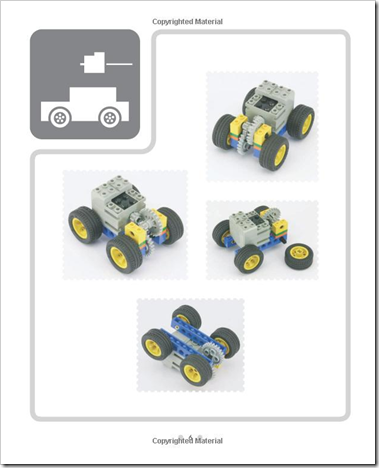
There's also a later model which shows how to add a trailer to
your cars to hold the battery pack if you want it to be completely
untethered. Some models incorporate the battery pack right into the
model. The one Ben and I built tonight used the Power Functions
battery pack as the main structural element in a four wheeled 2
gear vehicle.
One of the other things I like about these books is how they use
different colored pieces to clearly show you what you need in a
contraption. If you look at the picture above, you can clearly see,
even when viewed as a thumbnail on a webpage, the stack of elements
that make up the model. This is especially helpful considering that
most of my Technics parts are black or one of two shades of
gray.
For reference, here's the table of contents for the Wheeled
Wonders book.
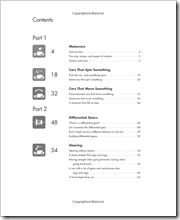
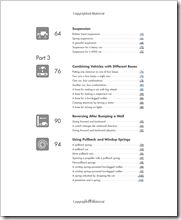
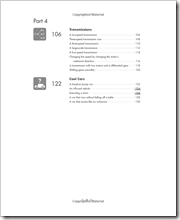
Simple Machines
The Simple Machines book starts off with some great information
on all the different ways you can connect various gears. It starts
off by explaining the sizes of each gear. One of my favorite pages
is this one which, without any words, explains how the gears will
spin, which gear will spin faster, and which one will have more
torque. If you have to limit yourself to only one book, and have a
number of gears to use, this is the one to get, as he shows just
about every possible way to connect gears, pulleys and more to make
something happen.
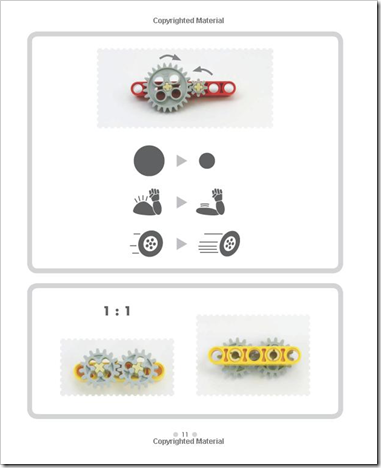
Fantastic Contraptions
The Fantastic Contraptions book is just plain fun. Once you
understand how gears work and want to move beyond the different
ways to make something drive across the floor, check this out. It's
just full of interesting "things". The title really says it all.
This book covers Pneumatics, lights, Solar panels, different
movements, walking machines, changeover mechanisms and more. Here's
one of the builds that uses the new Power Functions motor to create
a quadrapod.
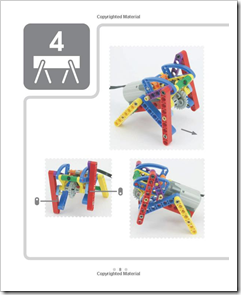
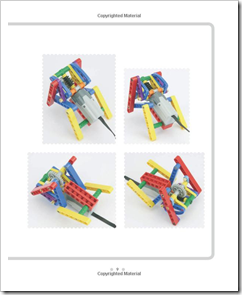
I've been very happy with these books. They've helped me to
understand different ways to connect things, and have given Ben and
I some inspiration for playtime. Most of the mechanisms are too
advanced for a 5 year old to build, but he certainly helps. Once
complete, he also adds his own embellishments such as lights
powered by the battery pack, a minifig seat, minifig control panel,
guns (of course), and a minifig driver. It's Lego, so he can add
all he wants. Fun stuff :)
You can find more information about these books, as well as
videos of some of the projects, on the publisher's
site.
